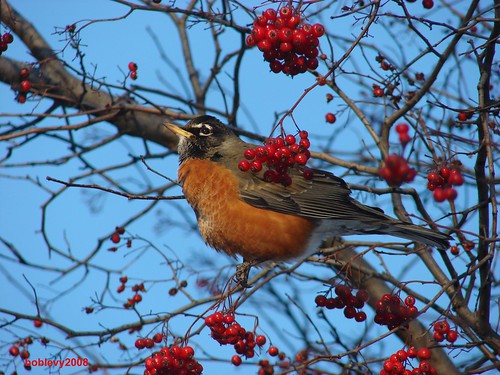tags: American robin, Turdus migratorius, birds, NYC, Central Park, Image of the Day
American robin, Turdus migratorius, among berries.
Image: Bob Levy, author of Club George. [larger size].
The photographer writes: A surprising number of people assume that all American Robins migrate south for the winter. We've all heard the expression suggesting that winter is over when we see the "first robin of Spring" when in fact a portion of the species remains with us all winter long. In Central Park, for example, every winter I find about two dozen robins foraging along the southern and western edge of the Great Lawn. I recently found them hard at work in a Hawthorn Tree. There were about twenty-five robins excitedly plucking off bright orange berries. Some were so into the process that they hovered in a kind of modified hummingbirdish way at the tips of the branches where most of the food was. That was my first surprise.
The second was the arrival of a lone Hermit Thrush, not a common winter visitor to the park, that frustrated my photographic efforts by keeping twigs between itself and the camera lens at all times.
A third surprise was the arrival of a Yellow-bellied Sapsucker that initially kept its back to the scene, then spun around, came toward me, snatched a berry in its beak rushed to an adjoining tree to eat it. The sapsucker was too quick for my shutter finger reflexes and I missed that chance for a close-up shot. Sigh.
A few Tufted Titmice, Black-capped Chickadees and a male and female Northern Cardinal (they were Mama and Papa Castle, two of the most usual of suspects, who have appeared on this blog) also came to dine. All the birds scattered when a Cooper's Hawk, the fourth surprise if you've been counting, zoomed low over the tree. There were no known casualties. All, I hope, returned later to safely continue with their feast.
- Log in to post comments


It's hard when you've gotten to know them, but that poor Cooper's has to eat, too.
Bob Levy,
Your four paragraphs of scenery description is as vivid as the photographs themselves. You provide, in addition, related scholarly information along with it. A naturalist poet, you are! Just keep on it; bring us photos and write clear, accurate, beautiful descriptions on what you see in the nature. We are forever hungery for it, and more.
Hey AriSan, if you are now or plan on becoming a literary agent or a publisher please let me know.
A great compliment indeed. Thank you.
What I'd like to know is what happened to Kansas? When we lived in the NW part of Indiana, we had dozens of different kinds of birds at our feeders all winter. Here in a town near Kansas City, we have only ONE cardinal, ONE bluejay and a few tiny birds with dark backs and wings and white underbellies who are also ground feeders. And our "back yard" is right on a wood line. During the summer we put a finch feeder out and saw NO finches. And we offered the best in Egyptian thistle too.
Is this normal for Kansas?